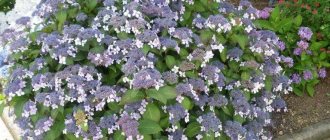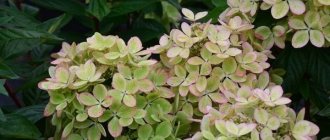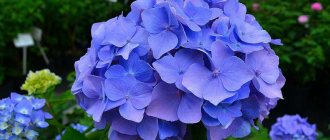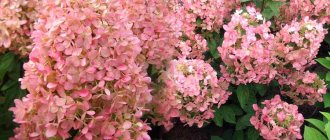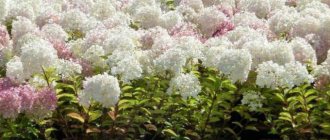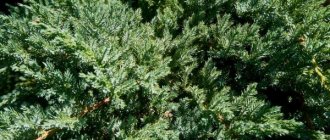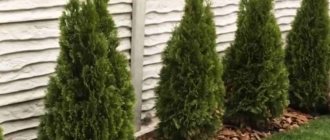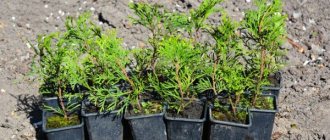Description of the plant
Serrated hydrangea (Hydrangeaserrata) is a type of garden hydrangea, a spreading, low-growing garden shrub, pleasing to the eye with its variegation and shape of inflorescences. Its name is Hydrangea (from the Greek hydor - water and angeion - vessel) means “vessel with water”. The sawtooth shape of the leaves (serrata - from the Latin “toothed”) gave the name to the species.
The root system is spreading, wide, fibrous, up to 40 cm deep. The large area of the suction surface and the shallow location of the root system determine the plant’s rapid response to fertilizers and soil pollution.
The leaf length is slightly less than that of its closest large-leaved relatives - up to 12 centimeters. Oval, pointed at the ends, they have jagged edges resembling a saw. They are the calling card and distinctive feature of serrated hydrangea.
The type of inflorescence is a corymbose panicle with a diameter of up to 8 centimeters. B - many small fertile variegated white-blue or white-pink flowers capable of cross-pollination. The edges of the inflorescence are decorated with larger four-leaved sterile flowers that do not have reproductive organs. After blooming, they have a uniform milky pink or blue color.
The strong, branched, bark-covered trunk of the shrub is hidden under a luxurious cap of inflorescences and foliage and is almost invisible. It has a height of up to 1.5 meters, is strongest at the base, and branches low.
Pruning and forming paniculate hydrangeas
This species is distinguished by its ability to form new flowering shoots on branches of any age. Such an abundant formation of flowering branches can lead to weakening of the plant and the appearance of small, inconspicuous inflorescences. To ensure that the inflorescences remain large and the flowering is abundant, the operation is carried out annually, regardless of what form of cultivation is chosen: a tree or a bush. In paniculate hydrangea, up to 3 shoots can grow from a healthy bud. Remove small branches directed inward, leaving those that grow outward. Shortening last year's shoots will be sufficient to increase the number of flowering branches.
Paniculata hydrangea after spring pruning
To form a bush, the seedling is buried in the ground when planted. Weak branches growing from the ground are cut out, strong zero ones are not touched, and with their help they form a bush. Emerging growths are shortened, leaving 1-3 buds, which promotes the appearance of new shoots with lush inflorescences. In this way, a spherical bush is formed.
To create a plant in the form of a tree, select a seedling with a well-defined trunk. For the first 2 years, it is necessary to remove underground shoots and trim the branches of last year, leaving 2-3 buds on each. The shoots formed from them will feed the trunk throughout the year. In the spring, they are cut out without leaving stumps, as a result of which a standard (trunk) is formed. It is attached to a support so that it stretches. In spring, the formation of the crown occurs due to the shoots of the previous year located in the upper part of the plant. For vertical growth, the shoots are tied up, pressing them against the trunk. When the tree reaches a height of 50 cm, they are shortened. Formation takes place over 3 years.
Popular varieties
When thinking about buying such a plant, you should first choose the appropriate variety.
Bluebird
If you need a bright blue accent in your flower garden, you can choose Hydrangea serrata "Bluebird". Characteristic features of the Blue Bird variety:
- A deciduous, spreading shrub with blue and purple flowers, used in individual or group plantings in parks, courtyards and garden plots.
- The inflorescences are very beautiful - flat, about 10 cm in diameter, with a floating color: in the middle they are pink-purple with blue stamens, at the edges - from light purple to bright blue, 2-3 cm in size (the flowers are light blue if the bush grows in acidic soils). Blooms profusely from late July to late September. Young plants also flower profusely.
- Grows well in fertilized acidic soils and requires abundant watering. The landing site must be protected from winds and drafts. The shrub is not frost-resistant; shelter for the winter is necessary.
Koreana
A small (40 cm), compact shrub with white-pink flowers collected in lush cone-shaped racemes. Does not require special care. It will be an excellent solution for decorating a gazebo or entrance to the house.
Preciosa
The Preciosa variety boasts the following characteristic features:
- a beautiful, dense, compact plant 100-120 cm high;
- the flowers are collected in thick caps, first yellowish-green, then pink and, by autumn, crimson-red;
- the diameter of the inflorescences is about 12 cm. The acidity of the soil does not affect the color of the flowers;
- sometimes the inflorescences contain both fruiting flowers (in the center) and barren flowers (at the edges), but not always;
- There are options when the inflorescence contains only barren flowers;
- For planting, a sunny or semi-shaded place is required, with well-drained nutritious soil;
- The shrub is winter-hardy and can withstand frosts down to -23 degrees.
Santiago
Medium-sized (130 cm), well-branched bush with lacy flowers changing color from pink to red. The leaves of this shrub also change color, turning red towards the end of the season. Excellent frost resistance and abundant flowering make this variety very popular.
Advantages and disadvantages of pruning types
In the fall, dried inflorescences are removed; in the winter, the branches sag under the weight of snow and can break or be damaged.
Trimming dried flowers in autumn
The rest of the work is left for the spring, because... the presence of cuts can cause the development of diseases and lead to a decrease in frost resistance. To perform spring pruning, nature has set a short deadline: before the start of sap flow.
The benefits of pruning in spring include:
- Improving the appearance by creating the required bush shape.
- Lush flowering due to increased growth of young branches after removing dried ones.
- It is easier to identify living and dying branches by color and the presence of swollen buds.
- The cuts will not be damaged by cold weather.
Important! After any pruning, the sections are disinfected with charcoal powder. It also stimulates the growth of new shoots.
Disadvantages of carrying out the procedure in spring:
- Short periods of time - during the period of rest and the beginning of the movement of juices. Being late will harm the plant and it will not bloom.
- Reducing the time for new shoots to grow.
- A shift in growth phases means that the hydrangea will not have time to ripen over the summer and prepare for winter.
How to plant serrata hydrangea
Experienced gardeners recommend planting serrated hydrangea in late April-early May or in mid-September, when temperatures become more moderate.
Selecting a location
Planting hydrangeas begins with choosing a suitable location. These are light-loving plants, so they grow well in open spaces, but direct sunlight is harmful to them.
Diffused light and partial shade are ideal. Therefore, they can be planted on the southern, eastern and western sides of fences and walls of buildings, which will help decorate and decorate them.
It is important that no other plants that love moisture grow within a radius of 3 meters from the hydrangeas, so that there is enough for everyone.
Soil preparation
The culture feels best in acidic soil. Hydrangea is planted on a substrate fertilized with manure or compost. The shrub loves moist, loamy soils. The substrate will be very dense, it is worth digging up the edges from below with a shovel, mixing the soil at the bottom with sand or gravel, providing drainage to the plant.
When planting, you need to prepare the following soil mixture (2:2:1:1):
- fertile humus;
- rotted leaves;
- peat;
- sand.
Additionally, fertilizers are added: urea (20 g), mineral complexes and organic matter. It is strictly forbidden to add lime, because hydrangea does not tolerate this type of feeding.
Pit Depth and Spacing
If you make a composition of hydrangeas, it is worth considering that the distance between them should be at least 1.5 meters. During planting, the root collar should be level with the ground.
The depth of the planting holes should be about 35 cm. After planting the plant, it is good to add a mulching component (needles, sawdust) to a layer of about 10 cm. This will help maintain moisture.
Step-by-step planting instructions
To properly plant serrated hydrangea, you must adhere to the following instructions:
- Prepare a nutritious soil mixture from the components indicated above.
- Dig a planting hole.
- Place the prepared soil mixture at the bottom of the hole.
- Place the seedlings in the center of the hole, the root collar should be flush with the ground surface.
- Sprinkle the empty space with earth.
- When planting, plants should be planted at the specified interval.
- Water the hole with water and add mulch.
Pruning and shaping tree hydrangea
For spring and autumn pruning of tree hydrangea, appropriate patterns are used. In autumn, only spherical inflorescences are cut off. In the spring they carry out:
- Sanitary pruning, removing broken, frozen ends of branches.
- Rejuvenating, completely removing old branches.
- Thinning, which consists of cutting out thin shoots incapable of flowering in the center of the bush and zero shoots that appear at the edges, to preserve the strength of the flowering bush.
- Pruning for flowering, when shoots from last year are shortened by 4 pairs of strong buds.
With the help of thinning, they form a beautiful bush in the shape of a bouquet. This species is distinguished by an abundance of zero shoots that grow directly from the ground, so the plant needs annual thinning to maintain its shape and lush flowering. A newly planted bush is formed by shortening and cutting off the shoots.
Tree hydrangea bush after pruning in spring
Caring for serrata hydrangea
Caring for serrated hydrangea is quite simple - you need to follow the rules of watering, provide suitable lighting and fertilizing, and also periodically loosen the soil and trim the bush.
Watering and lighting
Since the plant is a moisture-loving crop, it is recommended to moisten the soil in the tree trunk every day.
On hot summer days, when the thermometer rises above +30°C, watering should be done three times a day, and if the air warms up to 25°C, then twice (morning and evening). It is important to ensure that the top layer of soil is always moderately moist.
Although serrata hydrangea is a fairly light-loving plant, bright sun can harm it, like most plants. In this case, the earthen lump dries out faster, the flowers become small and pale, and unsightly burns appear on the leaves. If the plant is located in an open space, then at midday it should be artificially shaded. For example, a removable canopy. Such care allows you to maintain a decorative appearance.
Feeding
As for fertilizing hydrangeas, this procedure is carried out as follows:
- At the stage of bud formation and after flowering, the bush should be watered with a mixture made from a kilogram of peat, a kilogram of dry leaves and 500 grams of humus, which are diluted with two and a half liters of infused water.
- The prepared mixture is used to water the plant throughout the entire flowering period. In this case, once a week the root zone is treated with compost or dry grass.
It should be noted that hydrangea reacts poorly to limestone fertilizers, chalk or wood ash, so the use of such products is contraindicated.
It is also important to take extra care when using nitrogen-containing fertilizers. If there are too many of them, flowering will become excessively abundant, as a result of which the bush may be damaged. Urea or rotted compost should be applied only in the early stages of the growing season in strictly moderate quantities.
Loosening the soil and pruning
In order for the root system to quickly gain access to oxygen and moisture, it is necessary to loosen the soil near the bush. But it must be taken into account that this variety has very high root depth and deep loosening is contraindicated for it.
Hydrangea serrata requires annual pruning. The best time for this is autumn, when the plant has already bloomed and is entering a dormant state. You need to use garden pruners. Using such a tool, the upper 2–3 nodes of the shoot are cut off, while trying to give the shrub an elegant “cap” shape. All branches without flowers, dry leaves and dead branches should be removed.
This type of care is useful because after pruning, the area from which moisture evaporates during the winter is reduced. Summer trimming of branches is also allowed to make the bush more branched, lush and even. Also, every two years you should carry out a “radical pruning”, removing all dead, weak and uneven shoots - this will only benefit the plant, and the hydrangea will be transformed next year.
Pruning hydrangea in autumn
When the leaves on the bush have already turned yellow, or perhaps fallen off, when the charming inflorescences have begun to dry out, changing color to brownish, it’s time to take up the pruning shears!
Pruning tree hydrangea and pruning paniculata hydrangea have the same principle, despite the fact that these species have different bush shapes and grow according to their own rules. It is important to understand the essence of the process. We simply shorten the shoots to the second, third, fourth or even fifth bud from the base, regardless of whether it grows from a branch or directly from the ground, like a tree hydrangea. The main nuances that need to be taken into account when pruning hydrangea: - we form a neat hemispherical shape of the bush, for which you can trim the outer shoots a little shorter than those coming out from the middle of the crown;
— it is best to do autumn pruning by 3-4 buds, so that in the spring, if the shoot is damaged, you can trim the branch harder;
— quite often at the very base of tree-like hydrangeas you can see one or even two buds very close to each other. We count the buds for pruning the shoot above, without taking them into account. By heavily pruning the bush, we run the risk of awakening these low buds, and then from the very base the crown may become very thick, which will negatively affect both the health and the decorative appearance of the hydrangea.
- if the declared height of the hydrangea bush of the variety you have chosen is from two to four meters, then the distances between the buds will be large (from 10 to 20 centimeters), which means that pruning can be done on the third, and, if necessary, on the second bud. However, do not forget that adjusting the bush in the spring will be more difficult if there are too few buds left.
Diseases and pests
Serrated hydrangea Bluebird is resistant to almost all pests. Most often it is affected by chlorosis, powdery mildew, slugs and spider mites.
- With chlorosis, the leaves of the plant begin to lighten, but the veins do not change color. As a treatment and prevention, hydrangea is treated with a mixture consisting of 4 grams of potassium nitrate, 4 grams of vitriol and a liter of water.
- When powdery mildew appears, brown spots and a silver coating appear on the leaves. An effective control measure would be a solution of 10 grams of laundry soap and 2 grams of copper sulfate diluted in a liter of water. A good preventative measure would be to regularly spray the bushes with insecticides.
- Hydrangeas fall prey to slugs and snails. To avoid this, you can place the drug “Thunderstorm” in plastic cups under the bushes. Do not apply the drug directly to the soil, as it is toxic and pollutes it. The easiest way is to mechanically collect these pests.
- To get rid of spider mites, plants can be treated with a solution of the drug “Fufan” or “Typhos”. It is enough to dilute 5 ml of product in 5 liters of water.
Types of pruning paniculate hydrangea
In autumn, cone-shaped inflorescences and too long shoots are removed.
In the spring they carry out:
- Sanitary pruning, when only dried branches are cut off. This is a frost-resistant species, and there are no frozen shoots.
- Rejuvenating, during which branches with slow growth are removed. This species has a skeletal trunk and branches, like a tree.
- Shortening shoots for the growth of large inflorescences.
- Thinning cutting is used to remove excess shoots.
Important! Of the 3-4 shoots growing from one bud, the one that grows inside the bush is cut off.
Preparing for winter
Serrated hydrangea tolerates cold quite well in central Russia, but it is necessary to build a shelter until the plant gets stronger, that is, up to 4-5 years. You will also have to protect the shrub for the winter in northern and cold regions.
Work is carried out adhering to the following rules:
- First you need to carry out sanitary pruning.
- Then phosphorus and potassium fertilizers are scattered under the bush.
- In frosts down to -5 degrees, the bush is hilled and covered with polyethylene.
- Down to -15 degrees, hydrangea is tied with a rope, spud, covered with spruce branches, and a film is wrapped on top.
- At temperatures down to -20 degrees, the branches are bent to the ground and secured with metal brackets; sawdust, pine branches, old blankets, etc. are laid on top.
- In frosts down to -30 degrees, the shrub is wrapped in a metal lattice, covered with bricks and covered with old warm clothes on top.
Correctly and timely procedures for preparing hydrangeas for winter will guarantee that the plant will wake up healthy with the spring rays of the sun, and in the summer it will delight you with its flowering caps.
Proper planting and care of serrated hydrangea is quite simple. With the onset of July, this bush will bloom with bright caps of amazing colors, and will certainly become the main decoration of the garden.
Reproduction options
Flowers of serrated species consist of sterile and fertile flowers, so they can reproduce by seed. It is better to buy seeds from trusted sellers. They should be dried before planting. In addition, the method of cuttings and layering is very successful and simple.
Learn in more detail the best methods and timing for propagating hydrangeas.
Seeds
Sowing is carried out in February. A few days before, the seeds are placed in damp cotton wool to swell. Sow the material in wet sand, covering the container or pot with glass. For several weeks, every 2–3 days the seedlings are sprayed and condensation is removed from the glass. When sprouts appear, the cover is removed. With the appearance of the first pair of strong leaves, the seedlings dive into separate containers.
The substrate is taken as for a seedling. Until the plant grows up and forms a strong root system, it is kept in the house, on a lighted windowsill. Care consists of watering and fertilizing. Fertika fertilizer is applied to the soil twice a month, 5 g per pot. In autumn, feeding is stopped until spring. A 2–3-year-old bush is transplanted into open ground.
Read more about how to grow hydrangea from seeds.
By cuttings
Cuttings are taken at the beginning of summer from shoots of the current season. You need a piece of branch 6–8 cm long with 2 internodes and a pair of leaves. Root in wet sand, placing it in the substrate at an angle. The shoot is covered with a piece of plastic bottle. Regularly ventilate and spray the soil every 2-3 days. Next spring, the grown, rooted bush is transplanted to a permanent place.
By layering
Layers can be propagated at any time of the year, except late autumn and winter. You need to choose the longest branch from an adult plant. A narrow groove no more than 15 cm deep is dug under it. Part of the shoot, cleared of foliage, is placed in it.
Did you know? Buddhists have a tradition: on Buddha's birthday, tea from hydrangea leaves, called "amacha", is poured on the head of the statue of the deity in the temple.
The layering is sprinkled with soil, and its upper part is left on the surface. When caring for the mother bush, attention is also paid to the seedling. Next spring, the cuttings with roots are carefully separated from the donor and planted in a permanent place in the garden.
Hydrangea with serrated leaves will adequately decorate any corner of the site. Properly selected varieties and types of crops will turn the garden into a continuously blooming paradise.
Landing
It is recommended to purchase seedlings from nurseries. When purchasing, you need to inspect the bush. Good planting material has developed shoots with buds, a flexible and moist root system. The soil clod of a seedling with closed roots should not emit an unpleasant odor. To make sure of this, carefully dump the bush out of the container.
Site selection and soil preparation
For a serrated look, you need to choose a flat place, without slopes or holes. The root system of hydrangea is not located deep from the surface, only 40–55 cm, so the bush may not survive on hilly areas, especially if it is strewn with heavy inflorescences.
Check out the features of planting hydrangeas in open ground
Moisture, rain and melt water accumulate in the lowlands. The plant loves moisture in moderate portions, but not in excess. Diffused lighting is recommended: the shadow will make the inflorescences loose, and too bright and aggressive sunlight will burn the delicate petals and foliage.
The site is dug up and a mineral complex is introduced into the ground:
- urea - 20 g;
- potassium salt - 20 g;
- superphosphate - 25 g.
During digging, all plant debris from last year should be removed.
Landing dates
Planting dates depend on the region where the crop is grown. In the southern regions, planting is possible in the fall, after the heat has subsided and 1.5–2 months before frost. In the central and northern regions, planting is carried out in the spring. It could be April or May. The main condition is that the earth must be warmed up to at least +8°C.
Step-by-step instruction
When planting a group of plants, leave a gap of up to one and a half meters between them. The size of the pit is 50x50x60 cm.
Planting pattern:
- The soil removed from the hole is mixed with peat and sand in a ratio of 2:1:1.
- Some of it is poured onto pre-made drainage made of crushed stone or gravel in a layer of 15 cm.
- A seedling is placed on top and the roots are straightened.
- When the plant is covered with soil, monitor the position of the growth point - 3–5 cm above the ground level.
- Afterwards, watering is carried out using a bucket of water.
The tree trunk circle is covered with a layer of mulch of 6–8 cm. Material - peat, sawdust, tree bark.
Hydrangea Bluebird in landscape design
Landscape design experts recommend planting serrata hydrangea to give the area a blooming appearance. In the process of creating any composition, you need to take into account the fact that the distance between plants should be at least 1.5 m.
The flowering shrub goes well with astilbes or astrantias. Fans of minimalism will love the combination of Blueberry with lilac or mock orange. If there is a pond in the garden, then hydrangea can decorate its coastal zone. Thanks to its high frost resistance, the shrub will delight its owners from early spring to late autumn.
Important! To obtain a pink tint of flowers, designers recommend watering the plant with a weak solution of potassium permanganate; to color the flowers deep blue, use an aqueous solution of potassium alum.
Below are photos of the use of Bluebird serrata hydrangea in landscape design.
The plant is planted as a hedge along the garden path
The combination of different varieties allows you to achieve the natural brightness of a living fence
The view from the window of a blooming flowerbed will extend summer until October

